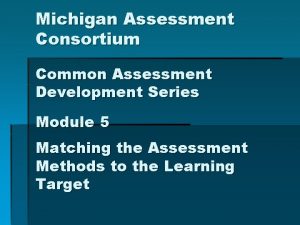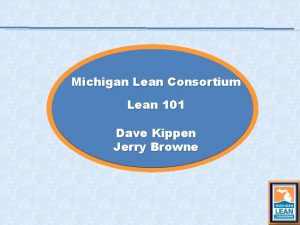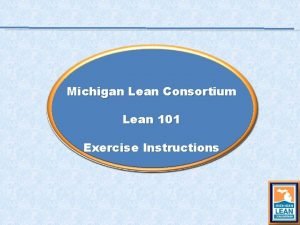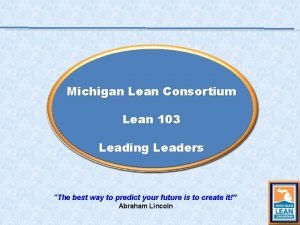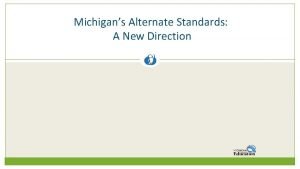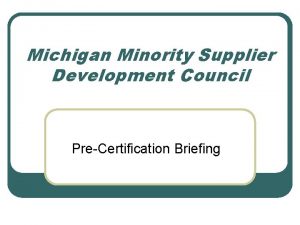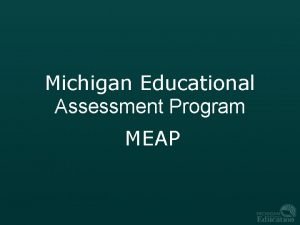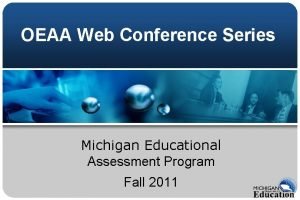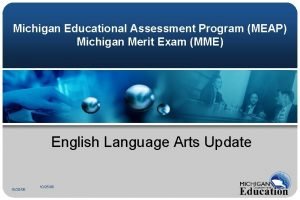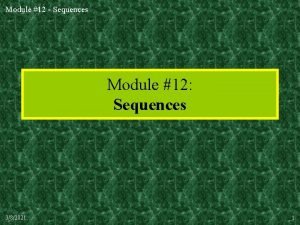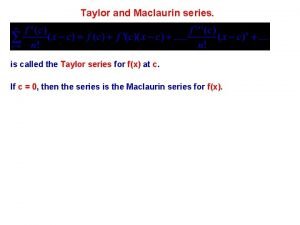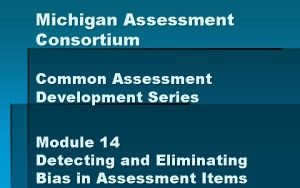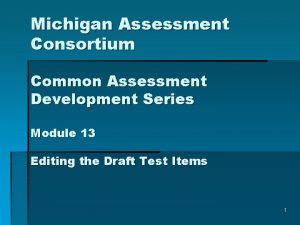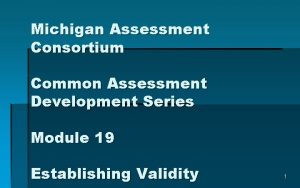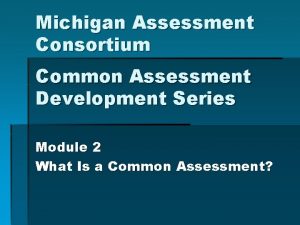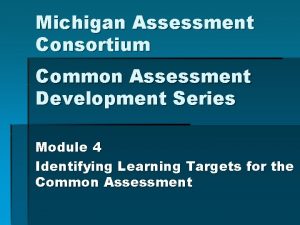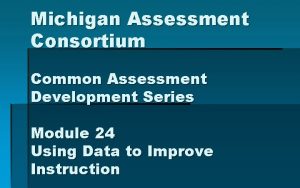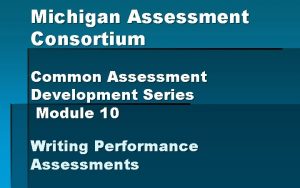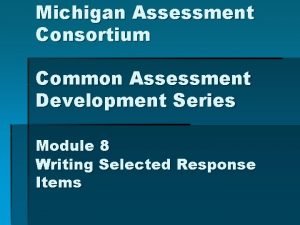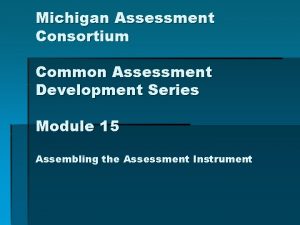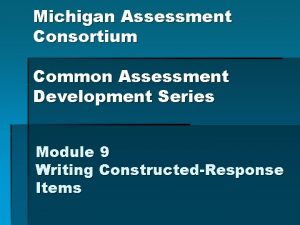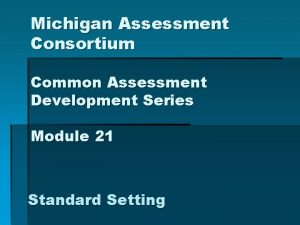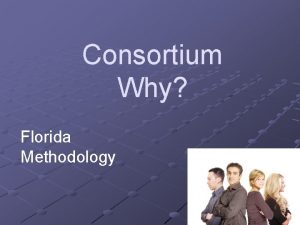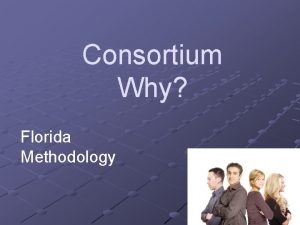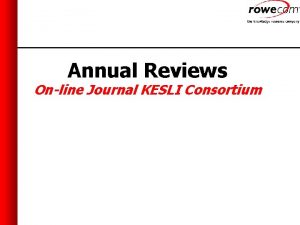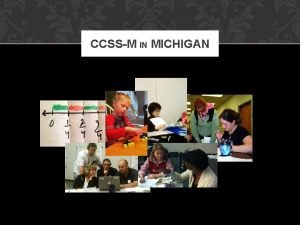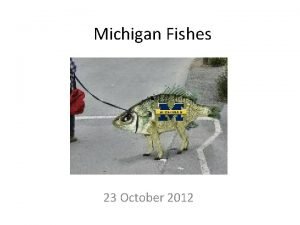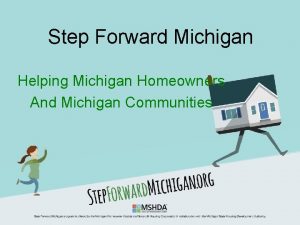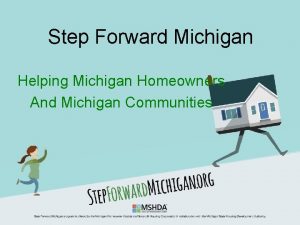Michigan Assessment Consortium Common Assessment Development Series Module





















- Slides: 21

Michigan Assessment Consortium Common Assessment Development Series Module 6 Assessing Students with Special Needs 1

Narrated By: Edward Roeber Michigan State University 2

The Goal of this Module is to: § Describe and illustrate how students with special needs can gain greater access to the content standards and learning targets on which common assessments are based § Relate how these students can be more fully included in the common assessments 3

Additional Design Issues § Having made decisions about types of assessments to use, which is good § There are important additional issues for each developer of common assessments to consider as well § If done, the assessments will be useable for all students 4

Providing Access § Instructional access begins with the way learning targets are worded § In reading, does the learning target say “decoding” or “comprehension” § What do your learning targets say? § This is also an assessment issue – making sure that the assessment matches the learning targets 5

Students with Special Needs § Students who may need assistance in accessing the learning targets and the assessments: § § § Students with mild to moderate disabilities Students with learning disabilities Students with physical disabilities English learners Title I students 6

Assessing Students with Special Needs § Help students participate in the common assessments by removing irrelevant wording and materials § Focus on the most essential part(s) of the learning target – the “essence” § Use “universal design” principles to write the assessments 7

Essence of the Learning Target § “Essence of the learning target ” means determining the most essential part(s) of the learning target - what parts of it are the most essential for a student to know or be able to do? § This part of the learning target is what should be emphasized in teaching and in assessment 8

An Example § Learning target as written: § Students will comprehend literary text § Essence statement: § Comprehend written material 9

An Example § Levels of access: 1. 2. 3. Recognize written materials such as books Pay attention to simple stories being read Listen to simple stories being read and respond to questions about it through pictures 4. Read simple stories and answer questions about it 5. Read stories and respond in writing to questions about it 10

An Example § The student’s score on the assessment might be a combination of: § Level of complexity of the task (the access level in the previous example) § Level of independence – how much of the task the student completed without assistance § Level of accuracy – how well did the student do on the assessment 11

Assessing Students with Special Needs § Educators familiar with the learning targets, with regular classroom instruction, and the types of students listed can work together to identify the most important aspects of the learning targets § You can determine the “essence of the learning target” and focus on this in assessment 12

Creating Essence Statements § Three types of individuals should be involved: § § § Regular classroom teacher Special education teacher Content specialists in the content area § These three individuals should meet to create the essence statements 13

Creating Essence Statements § First, the regular classroom teacher should describe how the learning target would be taught § The content specialist should listen to make sure that the lesson is aligned with the learning target and how alignment can be enhanced § The important element(s) of the learning target can emerge from this 14

Creating Essence Statements § Next, the special education or resource teacher should describe how the lesson laid out can be adapted or extended to work for the student with a disability or the English learner (EL) student § Both the content specialist and general education teacher should listen and suggest added ways in which the student can better access the standard 15

Creating Essence Statements § The three individuals should finalize the essence statement and develop 3 to 4 levels of access for these students § These ideas need to be written out and shared with the entire staff, since they any of the staff may work with these students 16

Assessment Development § Once access levels have been written, these levels can be used to create the assessments appropriate for these students § This will permit all students to access the same learning targets, albeit for some at a more “extended” level § This will benefit both student and the school 17

Resources § MDE Extended GLCE’s on the MI-Access website: § http: //www. michigan. gov/mde/0, 1607, 7 -14022709_28463 ---, 00. html § See also the handout that corresponds to this module; it provides some complete examples of extended standards with multiple access levels 18

Summary § In this module, you have learned one way to help students with disabilities and others (EL’s and Title I students) access the learning targets you teach all students § This will help these students access the common assessments you develop and use 19

Series Developers § § § § Kathy Dewsbury White, Ingham ISD Bruce Fay, Wayne RESA Jim Gullen, Oakland Schools Julie Mc. Daniel, Oakland Schools Edward Roeber, MSU Ellen Vorenkamp, Wayne RESA Kim Young, Ionia County ISD/MDE 20

Development Support for the Assessment Series § The MAC Common Assessment Development Series is funded in part by the Michigan Association of Intermediate School Administrators § In cooperation with § § § Michigan Department of Education Ingham and Ionia ISDs, Oakland Schools, and Wayne RESA Michigan State University 21
 Michigan assessment consortium
Michigan assessment consortium Michigan lean consortium
Michigan lean consortium Standard work training exercise
Standard work training exercise Michigan lean consortium
Michigan lean consortium Essential elements michigan
Essential elements michigan C device module module 1
C device module module 1 Michigan minority supplier development council
Michigan minority supplier development council Meap test michigan
Meap test michigan Oeaa
Oeaa Meap test questions
Meap test questions Hollila
Hollila Module 12 sequences and series
Module 12 sequences and series Maclaurin series vs taylor series
Maclaurin series vs taylor series Balmer series lyman series
Balmer series lyman series Maclaurin series vs taylor series
Maclaurin series vs taylor series Maclaurin polynomial
Maclaurin polynomial Ibm p series vs i series
Ibm p series vs i series Shunt shunt feedback amplifier
Shunt shunt feedback amplifier Series aiding and series opposing
Series aiding and series opposing Arithmetic sum formula
Arithmetic sum formula Taylor vs maclaurin
Taylor vs maclaurin Common mclaurin series
Common mclaurin series
